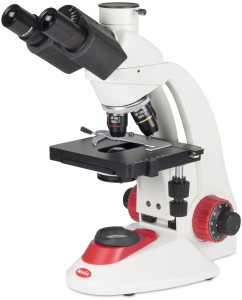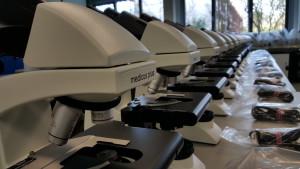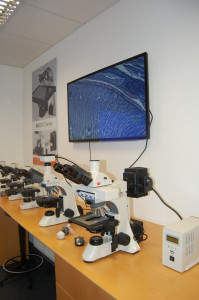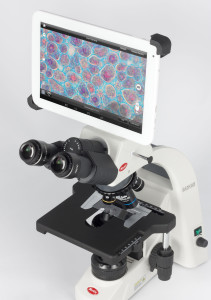Buy the Omegon Monoview microscope now and save 30%.
Promotional period: Nov 15th to Dec 31st,2024
 We proudly present a microscope series which is not available from too many sources: The RedLine from Motic.
We proudly present a microscope series which is not available from too many sources: The RedLine from Motic.
With their RedLine series, Motic has concentrated on the essential: the optics.
There is no 1240x magnification of a specimen with a resolution so low that the only thing magnified would be an empty image. Everything is available in a reasonable manner. With the most cost-effective models, a well thought-out offsetting mechanism replaces the cross table. Instead of binocular viewing, which is particularly difficult to adjust for children, the device comes with a monocular with photo tube or, indeed, an integrated camera.
Stereo microscopes, which are offered in the RedLine series with exchange lenses with 10/30x or 20/40x magnification, are particularly popular with children. The specimen stages are equipped with the patented “one touch” system. Both holding arms of the sample clip can be lifted with just one finger.
However, this is just the beginning of microscopy for young scientists. For older pupils there is obviously the binocular and the 100x magnification with immersion lens. Here the “Köhlersche illumination” makes sure that the light is precision-focussed on the specimen. Each microscope in this series is perfectly adapted to young scientists, and there are models available for any age group and application. Even the digitisation, which is indispensable in modern education, plays an important role.
Just look at the 13 models in our shop.
PISA (the Programme for International Student Assessment) is a study promoted by the Organisation for Economic Co-operation and Development (OECD), the last of which took place in 2015. For the Pisa Study the tasks in natural science were set up in the following form: Experiments were simulated and students were stimulated to look out for creative, new solutions. The results showed that expert knowledge is the strong point in Germany, for example. Internalizing scientific concepts and methods, while dealing with these concepts in a creative way appears to be more difficult for German pupils, for example, than for Asian children. This lack of creativity correlates with the statement that juveniles find natural sciences, neither particularly significant nor attractive, even if they perform very well in such subjects.
According to information issued by employers, in October 2016 a significant number of critical STEM (Science Technology Engineering and Maths) jobs will remain unfilled by skilled employees. Making instruction more exciting and scientific can achieve an improvement in STEM vacancies. Schools must therefore approach technical standards and teach the currently valid scientific methods. Juveniles of today have grown up in the digital world. But in the schools they are confronted with analogue scientific equipment from the last century.
On the one hand, this situation leads to demotivation, and on the other hand it gives the pupils a false impression of procedures used in modern science. The intensive development of already existing digital competences would be of utmost importance, because scientific work calls for the linkage of various programs for evaluation, processing and documentation of results. Scientific trials in schools should therefore also comprehensively illustrate this process. Some microscope manufacturers have realized this fact and developed simple, robust digital microscopes. For primary schools there are reasonable, excellent hand microscopes available, which are most suitable for outdoor use.
For the examination of materials, stereo microscopes with an integrated camera are the best choice. Pupils in the upper secondary use high-resolution, digital microscopes for their experiments. In combination with a PC, these microscopes enable a complete trial run with adequate documentation.
All microscopes are delivered with the corresponding software to control photography and further processing of the documented images. Providing a school with modern equipment is a major investment, which, in many cases, cannot be covered by the school budget. Should employers, who are desperately looking for experts in the STEM subjects, pay out of their own pockets?
| Upright microscopes | Motic | RED50X 40x- 400x; DM-5240x-400x; DM-111 40X – 1000X, monokular |
| Euromex | EcoBlue Series: 40x – 400x; 40x – 600x; 40x – 1000, monocular | |
| Euromex | BioBlue Series: 40x – 400x; 40x – 600x; 40x – 1000X | |
| Optika | B-150: 4x – 400x; DM-5UP : 40x – 400x , monocular | |
| Stereo microscopes | Euromex | EduBlue: 10x – 40x |
| Hand microscopes | Omegon | Omegon DigitalView USB-Hand Microscope |
| Euromex | Q-Scope: 200xSeveral models | |
| Bresser | USB-Hand Microscope incl. LED Stand |
Hund GmbH? Who is Hund GmbH? When it comes to high quality microscopes the names ZEISS and Olympus immediately spring to mind, but not Hund. Even though the company Hund is one of two who have their microscopes tested to meet the requirements of the Medical Device Act (§3 of the Medical Device Act). Of substantial effort: quality and suitability of the models is first tested by the German association TÜV, and, if positive, will receive a certificate. The manufacturer, in this case, Hund GmbH, must then guarantee uniform quality and issue an EC Declaration of Conformity. For this purpose each microscope that is intended for In-Vitro-Diagnostics is assembled and tested in Germany and is then marked with the CE-sign as a seal of approval.
 There are also limitations, when it comes to consultation (also by phone) and the sales of these products. According to §31 MPG any IVD – equipment must only be operated by qualified and trained personnel.
There are also limitations, when it comes to consultation (also by phone) and the sales of these products. According to §31 MPG any IVD – equipment must only be operated by qualified and trained personnel.
Based on our education as biologists and technicians we, the members of the microscopy team, have profound expert knowledge in selling JVD products. Since our visit to Co. Hund GmbH at the beginning of November, we also meet the requirements of an introduction into the specific “In-vitro-Diagnostica” from Co. Hund.
At the same time we had the opportunity to be convinced by the quality of the equipment, once again, a very enthusiastic experience. During our training course, Dr. Jörg Haus gave us an introduction to the optical details, which he did not mention in his book “Optical Microscopy”. Excited by this new experience, we will, in the future, create a new field “In-vitro-Diagnostic” and try hard to get further equipment from this area.
 Motic is a microscope manufacturer, who has specialized in digital microscopy and has taken a leading position in this field in the world market.
Motic is a microscope manufacturer, who has specialized in digital microscopy and has taken a leading position in this field in the world market.
The Motic manufacturing plant, including its research & development department with approx. 100 developing engineers, is located in Xiamen / China. Motic has branch offices all over the world, their German branch is located in the picturesque town Wetzlar, also the home of Leica and Hund.
In the middle of October, our microscopy team’s long lasting wish came true. We accepted an invitation to visit Motic in Wetzlar to receive an introduction to the brilliance of their microscope cameras.
After a comprehensive introduction, we transitioned over to the practical part of the training.
We had already viewed the HDMI-camera at the Analytica 2016 – cameras, which are particularly suitable for life transmissions in education.
The high image frequency in combination with impressive image sharpness had already convinced us by then.
The Moticam X can be recommended, if image processing and microscope are not positioned side by side. This may be in a laboratory or in the class room. The X2, which comes with its own battery and therefore acts completely independently, is particularly convincing. The control works via smartphone app or directly via the browser.
 Cameras in connection with tablets are in the meantime available from almost every company, but the Motic 5MP – camera with tablet holder deserves being highlighted by its extremely sharp, colour sensitive image and the user-friendly control program. Working with these cameras is simply fun and the price/performance ratio is OK.
Cameras in connection with tablets are in the meantime available from almost every company, but the Motic 5MP – camera with tablet holder deserves being highlighted by its extremely sharp, colour sensitive image and the user-friendly control program. Working with these cameras is simply fun and the price/performance ratio is OK.
Just a short note concerning the well-known 3 MP and 10 MP cameras, these well proven cameras are now available as 3MP+ and 10MP+ with USB 3- port, which increases the image transfer rate at a resolution of 2046 x 1536 from 3 to 16 fps (frames per second). As a supplement there is also a 5MP+ camera available.